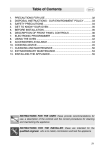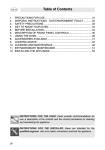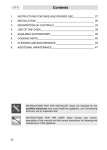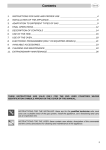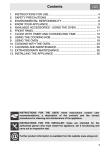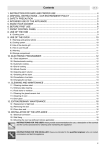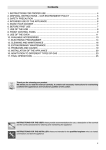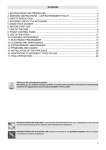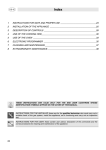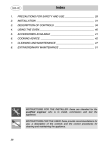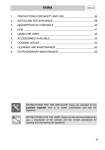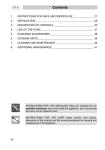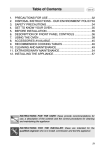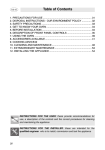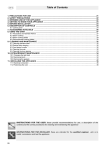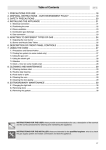Download Smeg SC04MFX Instructions for Installation and Use
Transcript
Table of Contents 1. 2. 3. 4. 5. 6. 7. 8. 9. 10. 11. 12. 13. 14. PRECAUTIONS FOR USE .................................................................... 4 DISPOSAL INSTRUCTIONS - OUR ENVIRONMENT POLICY ............ 5 SAFETY PRECAUTIONS ...................................................................... 6 GET TO KNOW YOUR OVEN ............................................................... 7 BEFORE INSTALLATION...................................................................... 7 DESCRIPTION OF FRONT PANEL CONTROLS ................................. 8 ELECTRONIC ANALOGUE CLOCK (ON SOME MODELS ONLY) .... 11 ELECTRONIC TIMER (ON SOME MODELS ONLY) .......................... 15 USING THE OVEN .............................................................................. 18 ACCESSORIES AVAILABLE............................................................... 20 COOKING ADVICE.............................................................................. 21 CLEANING AND MAINTENANCE ....................................................... 26 EXTRAORDINARY MAINTENANCE ................................................... 31 INSTALLING THE APPLIANCE........................................................... 32 INSTRUCTIONS FOR THE USER: these provide recommendations for use, a description of the controls and the correct procedures for cleaning and maintaining the appliance INSTRUCTIONS FOR THE INSTALLER: these are intended for the qualified engineer who is to install, commission and test the appliance 3 Precautions for use 1. PRECAUTIONS FOR USE THIS MANUAL IS AN INTEGRAL PART OF THE APPLIANCE. TAKE GOOD CARE OF IT AND KEEP IT TO HAND THROUGHOUT THE OVEN'S LIFE CYCLE. WE URGE YOU TO READ THIS MANUAL AND ALL THE INFORMATION IT CONTAINS CAREFULLY BEFORE USING THE APPLIANCE. INSTALLATION MUST BE CARRIED OUT BY QUALIFIED STAFF IN COMPLIANCE WITH THE RELEVANT REGULATIONS. THIS APPLIANCE IS INTENDED FOR HOUSEHOLD USE AND COMPLIES WITH THE EEC DIRECTIVES CURRENTLY IN FORCE. THE APPLIANCE IS BUILT TO PROVIDE THE FOLLOWING FUNCTION: COOKING AND HEATING FOODS; ALL OTHER USES ARE TO BE CONSIDERED IMPROPER. THE MANUFACTURER DECLINES ALL LIABILITY FOR USES OTHER THAN THOSE STATED ABOVE. NEVER USE THIS APPLIANCE FOR HEATING ROOMS. NEVER USE PACKAGING RESIDUES UNATTENDED IN THE HOME. SEPARATE THE VARIOUS PACKAGING MATERIALS BY TYPE AND CONSIGN THEM TO THE NEAREST SEPARATE DISPOSAL CENTRE. THIS APPLIANCE IS TAGGED UNDER EUROPEAN DIRECTIVE 2002/96/EC ON WASTE ELECTRICAL AND ELECTRONIC EQUIPMENT (WEEE). THIS DIRECTIVE CONTAINS THE REGULATIONS GOVERNING THE COLLECTION AND RECYCLING OF DECOMMISSIONED APPLIANCES THROUGHOUT THE EUROPEAN UNION. NEVER OBSTRUCT THE OPENINGS VENTILATION AND HEAT DISPERSAL. AND SLITS PROVIDED FOR THE NAMEPLATE WITH THE TECHNICAL DATA, SERIAL NUMBER AND MARK IS IN A VISIBLE POSITION ON THE OVEN DOOR FRAME. THE NAMEPLATE MUST NEVER BE REMOVED. NEVER USE METAL SCOURING PADS OR SHARP SCRAPERS; THEY WILL DAMAGE SURFACES. USE ORDINARY NON-ABRASIVE PRODUCTS WITH THE AID OF WOODEN OR PLASTIC UTENSILS IF NECESSARY. RINSE THOROUGHLY AND DRY WITH A SOFT CLOTH OR CHAMOIS LEATHER. DO NOT ALLOW SPILLS OF FOODS WITH HIGH SUGAR CONTENT (E.G. JAM) TO DRY INSIDE THE OVEN. IF THEY DRY FOR TOO LONG, THEY MIGHT DAMAGE THE ENAMEL COATING OF THE INSIDE OF THE OVEN. 4 Disposal instructions 2. DISPOSAL INSTRUCTIONS ENVIRONMENT POLICY - OUR Our products are only packaged using non-pollutant, environment-friendly, recyclable materials. We urge you to cooperate by disposing of the packaging properly. Contact your local dealer or the competent local organisations for the addresses of collection, recycling and disposal facilities. Never leave all or part of the packaging lying around. Packaging parts, and especially plastic bags, may represent a suffocation hazard for children. Your old appliance must also be disposed of properly. Important: deliver the appliance to your local organisation authorised to collect scrapped appliances. Proper disposal allows the intelligent recovery of valuable materials. Before scrapping your appliance it is important to remove doors and leave shelves in position as for use, to ensure that children cannot accidentally become trapped inside the oven during play. Also, cut the power supply lead and remove it and the plug. 5 Safety precautions 3. SAFETY PRECAUTIONS REFER TO THE INSTALLATION INSTRUCTIONS FOR THE SAFETY REGULATIONS FOR ELECTRIC OR GAS APPLIANCES AND VENTILATION FUNCTIONS. IN YOUR INTEREST AND TO ENSURE YOUR SAFETY, BY LAW ALL ELECTRIC APPLIANCES MUST ONLY BE INSTALLED AND SERVICED BY QUALIFIED STAFF, IN ACCORDANCE WITH THE RELEVANT REGULATIONS. OUR APPROVED INSTALLATION ENGINEERS GUARANTEE YOU A JOB WELL DONE. GAS OR ELECTRIC APPLIANCES MUST ALWAYS BE DISCONNECTED BY SUITABLY SKILLED PEOPLE. THE PLUG TO BE CONNECTED TO THE POWER SUPPLY LEAD AND THE RELATIVE SOCKET MUST BE OF THE SAME TYPE AND COMPLY WITH THE RELEVANT REGULATIONS. THE POWER SUPPLY SOCKET MUST BE ACCESSIBLE EVEN AFTER THE APPLIANCE HAS BEEN BUILT-IN. NEVER DISCONNECT THE PLUG BY PULLING ON THE POWER SUPPLY LEAD. THE APPLIANCE MUST BE CONNECTED TO EARTH IN COMPLIANCE WITH ELECTRICAL SYSTEM SAFETY REGULATIONS. IMMEDIATELY AFTER INSTALLATION, CARRY OUT A QUICK TEST ON THE APPLIANCE FOLLOWING THE INSTRUCTIONS PROVIDED LATER IN THIS MANUAL. IF THE APPLIANCE FAILS TO OPERATE, DISCONNECT IT FROM THE ELECTRICAL MAINS AND CONTACT YOUR NEAREST SERVICE CENTRE. NEVER ATTEMPT TO REPAIR THE APPLIANCE. NEVER PLACE INFLAMMABLE OBJECTS IN THE OVEN: IF IT SHOULD ACCIDENTALLY BE SWITCHED ON, THIS MIGHT CAUSE A FIRE. THE APPLIANCE BECOMES VERY HOT DURING USE. TAKE CARE NOT TO TOUCH THE HEATING ELEMENTS INSIDE THE OVEN. THIS APPLIANCE MUST NOT BE USED BY ANYONE (INCLUDING CHILDREN) WITH IMPAIRED PHYSICAL AND MENTAL CAPABILITIES OR INEXPERIENCED IN THE USE OF ELECTRICAL APPLIANCES, UNLESS SUPERVISED OR INSTRUCTED BY ADULTS RESPONSIBLE FOR THEIR SAFETY. BEFORE THE APPLIANCE IS PUT INTO OPERATION, ALL THE LABELS AND PROTECTIVE FILMS APPLIED INSIDE OR OUTSIDE MUST BE REMOVED. AFTER EACH USE, ALWAYS CHECK THAT THE CONTROL KNOBS ARE TURNED TO 0 (OFF). The manufacturer declines all responsibility for injury or damage caused by failure to comply with the above regulations or deriving from tampering with even just one part of the appliance and the use of non-original spare parts. 6 Instructions for the user 4. GET TO KNOW YOUR OVEN CONTROL PANEL OVEN LIGHT OVEN FAN (ON SOME MODELS ONLY) SHELF AND TRAY RUNNERS 5. BEFORE INSTALLATION Never leave packaging residues unattended in the home. Separate waste packaging materials by type and consign them to the nearest separate disposal centre. The inside of the appliance should be cleaned to remove all manufacturing residues. For further information about cleaning, see point "12. CLEANING AND MAINTENANCE". When the oven and grill are used for the first time, they should be heated to the maximum temperature for long enough to burn off any oily residues left by the manufacturing process, which might contaminate foods with unpleasant smells. After an electricity supply failure, for instructions for setting the time, see points "7. Electronic Analogue Clock (on some models only)" and "8. Electronic timer (on some models only)". 7 Instructions for the user 6. DESCRIPTION OF FRONT PANEL CONTROLS All the cooker's control and monitoring devices are placed together on the front panel. The table below provides the key to the symbols used. THERMOSTAT KNOB (on some models only) The cooking temperature is selected by turning the knob clockwise to the required setting, between 50° and 250°C. THERMOSTAT LIGHT Lights up to indicate that the oven is heating up. Goes out when the set temperature is reached; flashes at regular intervals to indicate that the temperature inside the oven is being kept constantly at the set level. 8 Instructions for the user THERMOSTAT KNOB (on some models only) The cooking temperature is selected by turning the knob clockwise to the required setting, between 50° and 250°C. To switch the oven on, turn the knob clockwise to any of the following functions, except the oven light function: NO FUNCTION SET SMALL GRILL ELEMENT LIGHT WIDE GRILL ELEMENT BOTTOM HEATING ELEMENT FUNCTION SELECTOR KNOB Turn the knob either way to select one of the following functions: NO FUNCTION SET TOP + BOTTOM HEATING ELEMENTS+FAN DEFROSTING GRILL ELEMENT + FAN TOP + BOTTOM HEATING ELEMENTS FAN HEATING ELEMENT GRILL ELEMENT BOTTOM HEATING ELEMENT + FAN BOTTOM HEATING ELEMENT GRILL ELEMENT + BOTTOM HEATING ELEMENT + FAN 9 Instructions for the user HOB CONTROL KNOB Used to regulate heating of the hob by turning the knob clockwise to the required setting, between 2 and 12. DUAL HEATING HOB CONTROL KNOB Used to regulate heating of the hob in dual heating zones. Turning the knob clockwise to between 2 and 12 heats only the smaller diameter area. Turning or symbol and the knob to the releasing it (it returns to 12) heats both the larger and smaller diameter areas. To regulate the heating level, turn the knob anti-clockwise to the setting required. To return to heating of the smaller diameter area only, turn the knob to 0 and then to between 2 and 12. MINUTE MINDER KNOB Setting is on a gradual scale and intermediate positions between the numbers can be used. The end of cooking buzzer does not turn off the oven. 10 Instructions for the user 7. ELECTRONIC ANALOGUE CLOCK (ON SOME MODELS ONLY) LIST OF FUNCTIONS MINUTE-MINDER BUTTON END OF COOKING BUTTON CLOCK TIME ADJUSTMENT AND RESET VALUE DECREASE BUTTON VALUE INCREASE BUTTON 7.0.1 "DEMO" Function Models with analogue/digital programmer feature a "DEMO" function which deactivates the heating elements while leaving the other functions unchanged. To activate it, simply press the , , and keys for 3/4 seconds. A confirmation beep will inform the user that the function is active. To deactivate it, simply repeat the same procedure. 11 Instructions for the user 7.0.2 Setting the time When the oven is used for the first time, or after an interruption in the electricity supply, the display flashes at regular intervals. Press for 1 / 2 seconds to stop the display flashing and start the procedure for setting the correct time. Press the value modification keys or to increase or decrease the setting by one minute for each pressure. Press one of the two value modification keys until the current time appears. 6/7 seconds after the last key is pressed, the clock will start from the time set. At the end of each programmed operation 8 beeps will sound 3/4 times at intervals of about 1 and a half minutes. This sequence can be stopped at any time by pressing any key. 7.0.3 Minute-Minder This function does not stop cooking; it simply activates the buzzer. • Press and the display will light up as shown in figure 1. • Within 6/7 seconds, press the or keys to set the timer. Each time a key is pressed, 1 outside segment, representing 1 minute of cooking time, will light up or go out. (figure 2 shows a cooking time of 10 minutes). 6/7 seconds after the last key is pressed, the countdown will start; when it finishes, the buzzer will sound. During the countdown, the current time can be • • • 12 viewed by pressing the key once; press it again to return to the timer display. At the end of the countdown, the oven must be switched off manually by turning the thermostat and function selector knob to 0. 1) 2) Instructions for the user 7.0.4 Programming Cooking duration: the 2nd button can be pressed to set the cooking duration. Before it can be set, the thermostat must be turned to the cooking temperature required and the function selector knob to any setting. To set the cooking duration, proceed as follows: • • • • • • Press the key for 1 / 2 seconds; the pointer will locate on 12 (Fig. 1). Use the and key to set the cooking duration: each pressure on the key adds 1 minute to the cooking duration, and every 12 minutes a new inside segment will light up (figure 2 shows a cooking duration of 1 hour). Once the duration required is obtained, cooking will start about 6 seconds after the last pressure 1) on or . 2) Once cooking has started the display will show the current time, represented by the constantly illuminated segments, and the minutes left to the end of the cooking time, represented by the flashing segments (each flashing segment means 12 minutes of cooking time left). At the end of the cooking time the timer will switch the oven heating elements off, the beeps will start to sound and the numbers on the dial will flash. The duration can also be reset by resetting the program selected: pressing the central key for 1 or 2 seconds will delete the duration set and the oven will have to be switched off in manual mode. Warning: it is not possible to set cooking durations of more than 6 hours. 13 Instructions for the user Starting cooking: as well as setting a cooking duration, the cooking start time can also be set (with a maximum delay of 12 hours in relation to the current time). To set the cooking start/end time, proceed as follows: • Set the cooking duration as described in the previous point. • Within 6/7 seconds of the last pressure on the or keys, press the key again to set the cooking start time. The current time will appear on the display with internal segments illuminated to show the end of • • cooking time. Use the and keys to set the cooking start time. 6/7 seconds after the last key is pressed, the display will show the current time and the cooking start and end times, which will be represented by the illuminated inside segments. The display segments will be constantly illuminated as long as the current time is not the same as the cooking start time; as soon as the current time reaches the set starting time, all the inside segments will start to flash, indicating that the oven has started cooking. At the end of the cooking time the timer will switch the oven heating elements off, the beeps will start to sound and the numbers on the dial will flash. • To reset the whole program set, keep the central key pressed for 1 or 2 seconds: if cooking has already started, the oven will have to be switched off by hand. • Here we can see a programming example: the current time is 7:06 and cooking is programmed to start at 8:00 and end at 9:00. • At 8 o'clock the inside segments between 8 and 9 will start to flash, while the hours hand will remain still. Warning: for the oven to start cooking operations after the programming procedures just described, the thermostat and function selector knob must correctly set on the temperature and function required. 8. ELECTRONIC TIMER (ON SOME MODELS ONLY) 14 Instructions for the user LIST OF FUNCTIONS MINUTE-MINDER BUTTON COOKING DURATION BUTTON END OF COOKING BUTTON VALUE DECREASE BUTTON VALUE INCREASE BUTTON MANUAL MODE BUTTON 8.1 Setting the time When the oven is used for the first time, or after an interruption in the electricity supply, the display flashes at regular intervals, showing Press to stop the display flashing. Press the value modification keys . or within 5 seconds to increase or decrease the setting by one minute for each pressure. Press one of the two value modification keys until the current time appears. Before each programmer setting, switch on the function and set the temperature required. 8.2 Semiautomatic cooking This function only switches the oven off automatically at the end of the cooking time. Press the key and the display will light up showing the figures ; keep it pressed, and at the same time use the value modification keys or to set the cooking duration. A few seconds after the key is released, the count of the programmed cooking duration will start and the display will show the current time together with the symbols A and . 8.3 Automatic cooking 15 Instructions for the user This function switches the oven on and off in fully automatic mode. Press the key and the display will light up showing the figures ; keep it pressed, and at the same time use the value modification keys or to set the cooking duration. Press the key and the display will show the sum of the current time plus the cooking duration just set: keep it pressed, and at the same time use the value modification keys or to adjust the cooking end time. A few seconds after the key is released, the programmed count will start and the display will show the current time together with the symbol A. When the cooking start time calculated automatically by the timer on the basis of the data entered is reached, the display will show the A and symbols together After the setting, to view the cooking time left press the key; to view the cooking end time press the key. The logic prevents the setting of incompatible values (e.g. the timer will not accept a cooking end time with a duration which is too long for this value). 8.4 Minute-Minder The programmer can also be used as an ordinary timer. Press the key and the display will show the figures ; keep it pressed and simultaneously press the value modification keys or . When the key is released the programmed count will start and the display will show the current time and the symbol . After the setting, to display the time left press the key. In timer mode, the system will not cut out operation of the oven at the end of the set time. 8.5 End of cooking At the end of the cooking time the oven will switch off automatically and simultaneously a buzzer will start to sound in on-off mode. After the buzzer is stopped, the display will return to showing the current time together with the symbol, indicating that the oven is again ready for use in manual mode. 8.6 Adjusting the buzzer volume The buzzer volume can be varied (3 settings) while it is in operation by pressing . 16 Instructions for the user 8.7 Stopping the buzzer The buzzer stops automatically after seven minutes. It can be stopped in manual mode by pressing the and keys together. To switch off the appliance, return all the knobs to the 0 setting in sequence. 8.8 Deleting the data set With the program set, keep the key of the function for deletion ( or ) pressed, while at the same time setting the value by pressing the value modification keys or . The timer will interpret deletion of the duration as the end of cooking. 8.9 Modifying the data set The cooking data set can be modified at any moment by keeping the key of the function for modification ( or ) pressed and at the same time pressing the value modification keys or . 17 Instructions for the user 9. USING THE OVEN Before using the oven, check that the display is showing the symbol (see point "8.1 Setting the time"). 9.1 Precautions and General Advice When the oven and grill are used for the first time, they should be heated to the maximum temperature for long enough to burn off any oily residues left by the manufacturing process, which might contaminate foods with unpleasant smells. During cooking, do not cover the bottom of the oven with aluminium or tin foil, and do not place pans or trays on it; this may damage the enamel coating. If you wish to use greaseproof paper, position it so that it does not interfere with the hot air circulation inside the oven. Oven accessories which may come into contact with foods are made from materials compliant with directive 89/109/EEC of 21/12/88 and relevant national regulations. To avoid unpleasant contact with any steam inside the oven, open the door in two stages: hold it halfopen (about 5 cm) for 4-5 seconds, then open it completely. If you have to carry out any procedures on foods, leave the door open for as short a time as possible to prevent a drop in the oven temperature which will impair the cooking results. When the door is opened the oven's internal fan cuts out automatically; it starts up again when the door is closed. 18 Instructions for the user 9.2 Cooling fan system (on some models only) The appliance is equipped with a cooling system which comes into operation when the oven is switched on. Operation of fans generates a normal air flow which comes out above the door and may continue for a short time even after the oven is switched off. 9.3 Inside light (Depending on model) Depending on the model, the oven light switches on: • when the oven door is opened, or • when the function knob is turned to any function. 19 Instructions for the user 10. ACCESSORIES AVAILABLE The oven is fitted with 4 runners for placing trays and shelves at different heights. Shelf: useful to support pans containing the food for cooking. Tray grid: for placing on top of a tray for cooking foods which may drip. Oven tray: useful for collecting fat from foods placed on the grid above. Baking tray: useful for cooking cakes, pizza and confectionery. Roof liner: remove it to simplify cleaning inside the oven. Chromium-plated gripper: useful removing hot shelves and trays. for Not all accessories are provided on some models. Optional accessories Original accessories can be ordered through our Authorised Service Centres. 20 Instructions for the user 11. COOKING ADVICE The oven should always be preheated in fan mode to 30/40°C above the cooking temperature. This considerably shortens cooking times and reduces electricity consumption, as well as giving better results. The oven door must be closed during cooking operations. 11.1 Conventional cooking FUNCTION SELECTOR THERMOSTAT 50 ÷ 250 °C This conventional cooking method, with heat from above and below, is suitable for cooking food on just one shelf. The oven must be preheated to the chosen temperature. Do not place the food in the oven until the thermostat light goes out. Place frozen meat in the oven directly, without thawing. The only precaution required is to set temperatures about 20°C lower and cooking times about 1/4 longer than for fresh meat. 11.2 Hot air cooking FUNCTION SELECTOR THERMOSTAT 50 ÷ 250 °C This system is suitable for cooking on several shelves, even with foods of different kinds (fish, meat, etc.) without cross-contamination of flavours or smells. The air circulation inside the oven ensures uniform heat distribution. Multiple cooking is possible provided that all foods require the same temperature. 21 Instructions for the user 11.3 Delicate cooking FUNCTION SELECTOR THERMOSTAT 50 ÷ 250 °C This type of cooking, for which it is extremely important to preheat the oven in fan mode, is particularly suitable for finishing cooking of foods underneath, or for processes which require heat mainly from below. The tray should be placed on the bottom runner. 11.4 Grilling FUNCTION SELECTOR THERMOSTAT O / Used for quick browning of foods. For short processes and small amounts, place the shelf on the fourth runner from the bottom. For longer cooking times and grilling, place the shelf on lower runners, depending on the size of the food. Keep the door closed when grilling is in progress. Grilling with the door open may permanently damage the oven and reduce operating safety. 11.5 Hot air grilling FUNCTION SELECTOR THERMOSTAT 200 °C Allows uniform heat distribution with better penetration to the core of foods. Foods are lightly browned on the outside but still soft on the inside. During cooking the oven door must be closed, and the maximum heating time must not exceed 60 minutes. 22 Instructions for the user Keep the door closed when grilling is in progress. Grilling with the door open may permanently damage the oven and reduce operating safety. 11.6 Defrosting FUNCTION SELECTOR THERMOSTAT 0 The air movement provided by the fan alone thaws foods more quickly. The air circulating inside the oven is at room temperature. Defrosting at room temperature has the advantage that the food's flavour and appearance are retained intact. 23 Instructions for the user 11.7 Recommended cooking tables Cooking times, for meat in particular, vary depending on the food's thickness and quality and personal preference. All times are calculated with the oven preheated. CONVENTIONAL COOKING RUNNER POSITION FROM THE BOTTOM TEMPERATURE °C. TIME IN MINUTES 2-3 2-3 210 - 230 210 - 230 30 40 2 2 2 2 2 2 2 2 170 - 200 210 - 240 170 - 200 170 - 200 170 - 200 140 - 170 170 - 200 170 - 200 30 - 40 PER Kg. 30 - 40 PER Kg. 30 - 40 PER Kg. 45 - 60 45 - 60 45 - 60 50 - 60 40 - 50 FISH 1-2 170 - 200 Depending on size PIZZA 1-2 210 - 240 40 - 45 CONFECTIONERY PASTRY SPONGE CAKE CROISSANTS FRUIT CAKE ANGEL CAKE APPLE CAKE RICE CAKE 1-2 1-2 1-2 1-2 1-2 1-2 1-2 170 - 200 165 170 - 200 170 - 200 170 190 180 15 - 20 35 - 45 40 - 45 20 - 30 60 60 60 PASTA LASAGNE PASTA BAKES MEAT ROAST VEAL ROAST BEEF ROAST PORK CHICKEN DUCK GOOSE-TURKEY RABBIT LEG OF LAMB GRILLING RUNNER POSITION FROM THE BOTTOM PORK CHOP PORK FILLET FILLET STEAK SLICED LIVER VEAL ESCALOPES HALF CHICKEN SAUSAGE MEATBALLS FISH FILLET TOASTED SANDWICHES 24 4 3 3 4 4 3 4 4 4 4 TIME IN MINUTES 1ST SIDE 7-9 9 - 11 9 - 11 2-3 7-9 9 - 14 7-9 7-9 5-6 2-4 2ND SIDE 5-7 5-9 9 - 11 2-3 5-7 9 - 11 5-6 5-6 3-4 2-3 Instructions for the user HOT AIR COOKING RUNNER POSITION FROM THE BOTTOM TEMPERATURE °C TIME IN MINUTES 2 2 2 190 - 210 190 - 210 190 - 210 20 - 25 25 - 30 20 - 25 2 2 2 2 2 2 2 2 2 2 2 150 - 170 150 - 160 160 - 170 160 - 180 130 - 150 170 - 180 170 160 - 170 150 - 160 150 - 160 160 - 170 140 - 170 65 - 90 70 - 100 65 - 90 35 - 45 100 - 130 40 - 45 70 - 90 100 - 160 160 - 240 80 - 100 30 - 50 15 - 25 FISH 2-3 150 - 170 Depending on size PIZZA BREAD TOASTED SANDWICHES 2-3 2-3 1-2 210 - 240 190 - 210 220 - 240 30 - 50 40 7 CONFECTIONERY SPONGE CAKE FRUIT CAKE CROISSANTS PASTRY RICE CAKE APPLE CAKE ANGEL CAKE 2-3 2-3 2-3 2-3 2-3 2-3 2-3 150 - 160 150 - 160 150 - 160 150 - 160 150 - 160 150 - 160 150 - 160 35 - 45 40 - 50 40 - 60 25 65 65 65 PASTA LASAGNE PASTA BAKES CREOLE RICE MEAT ROAST VEAL ROAST PORK ROAST BEEF FILLET STEAK ROAST LAMB RARE ROAST BEEF ROAST CHICKEN ROAST DUCK ROAST TURKEY ROAST RABBIT ROAST HARE ROAST PIGEON 25 Instructions for the user 12. CLEANING AND MAINTENANCE Before carrying out any operations, disconnect the appliance from the electricity supply. Never use a jet of steam for cleaning the inside of the oven. 12.1 Cleaning stainless steel To keep stainless steel in good condition, it must be cleaned regularly, after each use of the oven, after allowing it to cool. 12.2 Routine daily cleaning When cleaning and caring for stainless steel surfaces, always use only specific products which do not contain abrasives or chlorine-based acids. Instructions for use: pour the product onto a damp cloth and wipe over the surface, then rinse thoroughly and dry with a soft cloth or chamois leather. 12.3 Food stains or spills Never use metal scouring pads or sharp scrapers; they will damage surfaces. Use ordinary non-abrasive products with the aid of wooden or plastic utensils if necessary. Rinse thoroughly and dry with a soft cloth or chamois leather. Do not allow spills of foods with high sugar content (e.g. jam) to dry inside the oven. If they dry for too long, they might damage the enamel coating of the inside of the oven. 26 Instructions for the user 12.4 Cleaning the oven To keep the oven in good condition, it must be cleaned regularly, after allowing it to cool down. Remove all removable parts. • • Clean the oven shelves with hot water and non-abrasive detergents, rinse and dry. For easier cleaning, the door can be removed (see point “12.6 Removing the door”). 12.5 Cleaning the oven with self-cleaning liners (on some models only) The oven is fitted with enamelled liners that are continuously self-cleaning. These liners simplify cleaning of the oven and ensure it continues to perform well over time. 12.5.1 Using the self-cleaning liners To keep the inside of the oven clean and free from food residues and unpleasant smells, it should periodically be operated empty at a temperature of at least 200° C for a time varying between 30 and 60 minutes. This allows the self-cleaning liners to oxidise any deposits present, which can then be wiped away with a damp sponge once the oven has cooled. 12.5.2 Maintenance of self-cleaning liners The liners should not be cleaned using abrasive creams and ordinary cleaners. Simply wipe with a damp sponge to avoid damaging the special enamel coating. 27 Instructions for the user 12.5.3 Removing the self-cleaning liners Remove all accessories from the inside of the oven and proceed as follows: 1 Remove the side runners (fig.1); 2 Extract the side liners “F” and “G” (fig. 2); 3 Extract the back liner “A” after undoing the threaded ring-nut “C” (fig. 2); 4 Replace the liners in their original positions. 1) 2) 12.6 Removing the door 12.6.1 Removing doors with mobile hinges With the door completely open, lift the levers A of the two hinges until they touch the hinges B and take hold of the two sides of the door with both hands close to the hinges themselves. Raise the door to an angle of about 45° and remove it. If the hinges have not locked, repeat the operation, raising the levers A and keeping the door slightly raised. To reassemble, fit the hinges B into their grooves, then lower the door into place, ensuring that it remains fitted into the grooves C, then lower the levers A. 28 Instructions for the user 12.6.2 Removing doors with pins Open the door completely and insert the pins (supplied) into the holes from the inside. Close the door to an angle of about 45° and lift it off. To reassemble, fit the hinges into their grooves, then lower the door into place and extract the pins. 12.7 Removing the door glazing The glass in the door should always be kept thoroughly clean. For easier cleaning, the door glazing can be fully removed by proceeding as described below. After blocking the door in position as described in point "12.6 Removing the door", remove the inner glass using leverage as shown in figure 1, and release the 4 pins which fix the glass to the door. If your oven also has the middle glass (figure 2) this can simply be lifted out. After cleaning, first fit the middle glass (if featured on your oven) and then replace the inner glass, using the oven door supports as a fulcrum as shown in figure 3 (see detail A in figure 3. Once the glass has been fitted on the door, apply a little pressure against the 4 fixing pins. If the door should close during these operations, simply relock one of the hinges as described in point "12.6 Removing the door". The panes of glass can now be washed separately. 29 Instructions for the user 1) 2) 3) Use absorbent kitchen roll; remove stubborn dirt with a damp sponge and ordinary detergent. Warning: before removing the panes of glass, make sure that the door has been locked in open position as described in points "12.6 Removing the door". This operation might have to be repeated during the removal process if the door is accidentally freed. To replace the panes of glass in the oven door, follow the instructions provided in reverse order. WARNING. Never use the oven without the glass fitted: the outside surface of the door overheads 30 Instructions for the user 13. EXTRAORDINARY MAINTENANCE Occasionally, the oven will require minor servicing procedures or the replacement of parts subject to wear and tear, such as gaskets, light bulbs, etc. The specific operations for each procedure of this kind are provided below. Before carrying out any operation involving access to live parts, disconnect the appliance from the electricity supply. 13.1 Changing the light bulb Remove the protective cover A by unscrewing it anti-clockwise and replace the bulb B with another of the same type (25 W). Replace the protective cover A. Use only light bulbs approved for ovens (T 300°C). 8-function model with glass front panel. The standard light bulbs are of halogen type: do not touch them with your fingers, wrap them in an insulating material. Use only light bulbs available from our authorised service centres. 13.2 Removing the gasket To allow thorough cleaning of the oven, the door gasket can be removed. Before removing the gasket, remove the oven door as described above. Once the door has been removed, lift the tangs at the corners as shown on the right. 31 Instructions for the installer 14. INSTALLING THE APPLIANCE 14.1 Electrical connection The nameplate with the technical data, serial number and mark is in a visible position on the oven door surround. The nameplate must never be removed. The appliance must be connected to earth in compliance with electrical system safety regulations. If a permanent connection is used, the appliance's power supply line must be fitted with an omnipolar breaking device with contact gap of at least 3 mm, located in an easily accessible position close to the appliance itself. If a socket and plug connection is used, check that they are of the same type. Do not use reducers, adapters or junctions since they may cause overheating or burns. 14.1.1 Ovens with hob controls On ovens with hob controls the power supply lead is not supplied. Use a H05RR-F or H05RN-F rubber cable and when positioning it ensure that it does not touch the metal parts of the appliance's external casing. To access the terminal board, remove the appliance's back cover by unscrewing the relative screws. If necessary, change the positions of the jumpers on the terminal board as shown, then connect the wires, making sure that the earth wire is at least 20 mm longer. Fix the power supply lead to the appliance using the cable clamp provided. 32 Instructions for the installer Operation at 220-240 V~: use a H05RR-F / H05RN-F three-wire cable (cable of 3 x 4 mm2). Operation at 380-415V2N~: use a type H05RR-F / H05RN-F four-wire cable (cable of 4 x 2.5 mm2). Operation at 380-415V3N~: use a type H05RR-F / H05RN-F five-wire cable (cable of 5 x 1.5 mm2). The earth wire (yellow-green) must be at least 20 mm longer than the other wires at the end for connection to the appliance. 14.2 Positioning the oven The appliance is designed for building-in to cabinets made from any heatresistant material. Comply with the dimensions shown in figures 1, 2, and 3. When installing under worktops, comply with the dimensions shown in figure 1-3. When installing under worktops incorporating combined hobs, a gap of at least 110 mm must be left from any side wall, as shown in figure 1. When installing in tall units, comply with the dimensions shown in figure 1-2, bearing in mind that the top/rear of the unit must have an opening 8090 mm deep. Screw the 4 screws A into the inside of the frame (fig. 1). For installation under counter-top hobs, make sure that the rear/bottom of the unit has an opening similar to that shown in figure 1 (ref. B). See the instructions supplied with the hob for the relative positioning and fixing procedures. 33 Instructions for the installer Never use the door for leverage when inserting the oven in the cabinet. Never apply excessive pressure to the open door. 34 Instructions for the installer 14.3 Hob-oven connection Once installed, the combined hob must be connected to the oven. Fit the oven into the built-in installation opening, leaving enough room to carry out the operations described below: connect the yellow-green earth wire of the hob to the oven's earth terminal A (see figure); connect the hob connectors to the sockets provided on the top casing of the oven. The colours and symbols of the connectors must correspond to those on the oven sockets; if the hob has a residual heat warning device connector, connect it to the unused socket on the right-hand side. At this point the oven can be completely built-into the cabinet, taking care to place the power supply lead along the best possible route and ensuring that it is not touching hot parts. 35

































